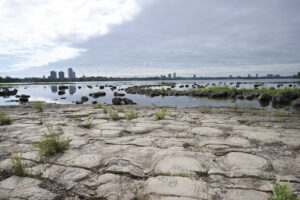Fortunes changed in 1997. Nicholls received funding to study ichthyosaurs and spent a month on the banks of the Sikanni Chief to investigate further. After locating the behemoth’s skull, she decided the skeleton must be excavated to preserve its scientific value. She raised funds and partnered with paleontologist Makoto Manabe of the National Museum of Nature and Science in Japan to kick off three gruelling and logistics-heavy field seasons between 1999 and 2001. While on site, the team was isolated, plagued by mosquitoes and constantly vigilant for bears.
One of the biggest obstacles was the removal of the skull, says Brinkman. More than 5.8 metres long and encased in rock, its removal required heavy-duty equipment such as an air-compressor, jackhammers and power saws, all of which needed to be airlifted in. Then, the massive skull had to be cut into blocks that could be flown out. The largest piece, containing the braincase and eye socket, weighed 4.5 tonnes, which was thankfully just under the load limit for industrial helicopters working on the project.
After an arduous field effort, the colossal skeleton made it to the Royal Tyrrell Museum, where it is today. Years of meticulous cleaning and measurements revealed a 220-million-year-old ichthyosaur that was more than 21 metres long and 30 per cent larger than its nearest relative. Nicholls named it Shonisaurus sikanniensis, and though bits of possibly larger specimens have been found, Brinkman says it remains the largest ichthyosaur confirmed by a near complete skeleton.
Nicholls would not get the opportunity to see her work published in a scientific journal. “I am losing my battle with cancer,” she wrote in an email in September 2004. “Please see that the page proofs for my Shonisaurus manuscript are sent to my co-author, Dr. Makoto Manabe, in Tokyo.” She died in October of that year. The paper was officially published in December.
In recent years, paleontologists have debated the feeding habits of ichthyosaurs. While Nicholls thought Shonisaurus sikanniensis was a filter feeder, others suggest that ichthyosaurs may have been marine predators, sucking in smaller aquatic animals the way beaked whales inhale squid. Had she lived longer, Nicholls would have undoubtably been integral to the scientific charge toward the truth. Today’s discussion would not have been the same without Nicholls’ discovery, says Brinkman. “It was a benchmark we wouldn’t know about had she not done this work.”






